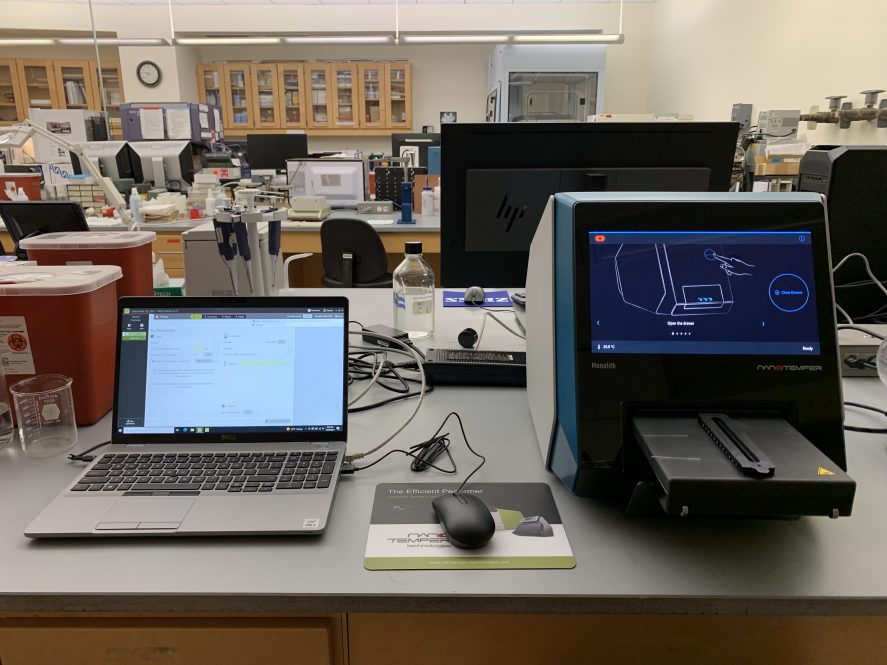Just about every process in our bodies relies on molecules interacting with each other. Measuring these interactions is an important step in understanding diseases and drug development.
The UConn Biophysics Core Facility received a $190,000 S10 grant from the National Institutes of Health to purchase a microscale thermophoresis (MST) instrument. This instrument will enhance the ability of UConn and UConn Health researchers to measure molecular interactions.
The Biophysics Core Facility is part of the UConn Center for Open Research Resources and Equipment (COR2E). COR2E consists of 11 individual units providing various state-of-the-art resources, services, and expertise to researchers across the University. The goal of the facility is to support research on the biophysical characteristics of molecules and proteins and interactions between molecules.
The new MST instrument measures how tightly one molecule binds to another molecule – including interactions so tight that currently available instruments can’t measure them.
The facility had been renting an older version of the MST instrument, which had limited capabilities and could only measure down to nanomolar binding affinities. This grant has allowed the Core Facility to permanently house the most up-to-date, state-of-the art technology.
“It’s a big step up for us that we will have this capability permanently,” Heidi Erlandsen, director of the Biophysics Core Facility, says. “It’ll be the go-to instrument for a lot of biophysical researchers in the future.”
Researchers at UConn Storrs and UConn Health will be able to take advantage of this technology this spring. The acquisition will directly advance the work of 16 externally funded UConn researchers who study protein interactions and small-molecule drug discovery. In total, this acquisition could immediately benefit as many as 30 labs at the University working with biological systems that study molecular interactions. For example, the instrument will support work on novel drug discovery and also can help identify how mutations in a protein can result in alternative bindings associated with disease, such as for the proteins found in the coronavirus.
“This instrument is perfect for that – to quickly find out what drug or small molecule binds better and prevents viral function,” Erlandsen says. “It’s already become very important for drug discovery at UConn.”
The MST instrument has several key advantages over alternative means of measuring biomolecular interactions. Firstly, it is immobilization-free technology. One current standard method, Surface Plasmon Resounance, (SPR) has the researcher bind the protein to a stationary chip. It then runs the molecule one wants to determine the protein’s interactions with over the chip. MST technology, by contrast, allows the proteins to move more freely in solution, which a much closer approximation to how the protein would move and interact in the body.
The MST instrument requires very small volumes (~10 microliters) of sample, compared to 100 to 450 microliters using other kinds of technology, to generate the data. Purifying proteins for analysis in this kind of instrument is a time and labor-intensive process, so the less of a sample needed to perform an analysis, the better.
It also runs each sample in just 20 minutes compared to a day or more using similar instruments.
James Cole, professor of molecular and cell biology, says this new instrument will support his research on COVID-19 treatments. Cole is searching for small molecules that can bind to a protein from the SARS-CoV-2 virus called nsp15 that it needs to replicate. These molecules inhibit the activity of nsp15 and will serve as leads for developing drugs to treat COVID-19 patients.
The MST instrument will allow Cole to perform experiments to determine how well different molecules bind to nsp15 that are impossible using typical methods which require too much sample.
“It should increase our throughput – our ability to characterize more of the compounds we have more readily,” Cole says.
Being able to run these experiments with the MST instrument will provide Cole with better data to use as the basis for continuing his line of inquiry for developing COVID-19 treatments.
Kyle Hadden, professor of medicinal chemistry, develops small molecules for anti-cancer drugs. One of the most important parts of his work is determining how well each of the compounds Hadden’s lab develops bind to the proteins of interest. The MST instrument will allow them to do this faster, cheaper, and more effectively.
“It’s really going to help us speed up the process and let us test those compounds and get some good data,” Hadden says.
The new MST instrument will advance several of Hadden’s projects. One such project is developing a compound to inhibit the translesion signaling pathway. This pathway is responsible for allowing our cells to copy their DNA and replicate. This pathway can also allow cancer cells to override first-line chemotherapy drugs aimed at shutting down that process. This can lead to relapse and resistance.
Hadden is specifically targeting a protein called Rev-1 that holds all the other proteins necessary for this process together. Developing a compound that can bind to Rev-1 in cancer wells will effectively inhibit translesion signaling.
“It wipes out all the hard work done by the cancer-fighting drugs,” Hadden says. “We’re trying to develop a compound that inhibits translesion signaling so it prevents that mechanism from rescuing the cancer cells.”



